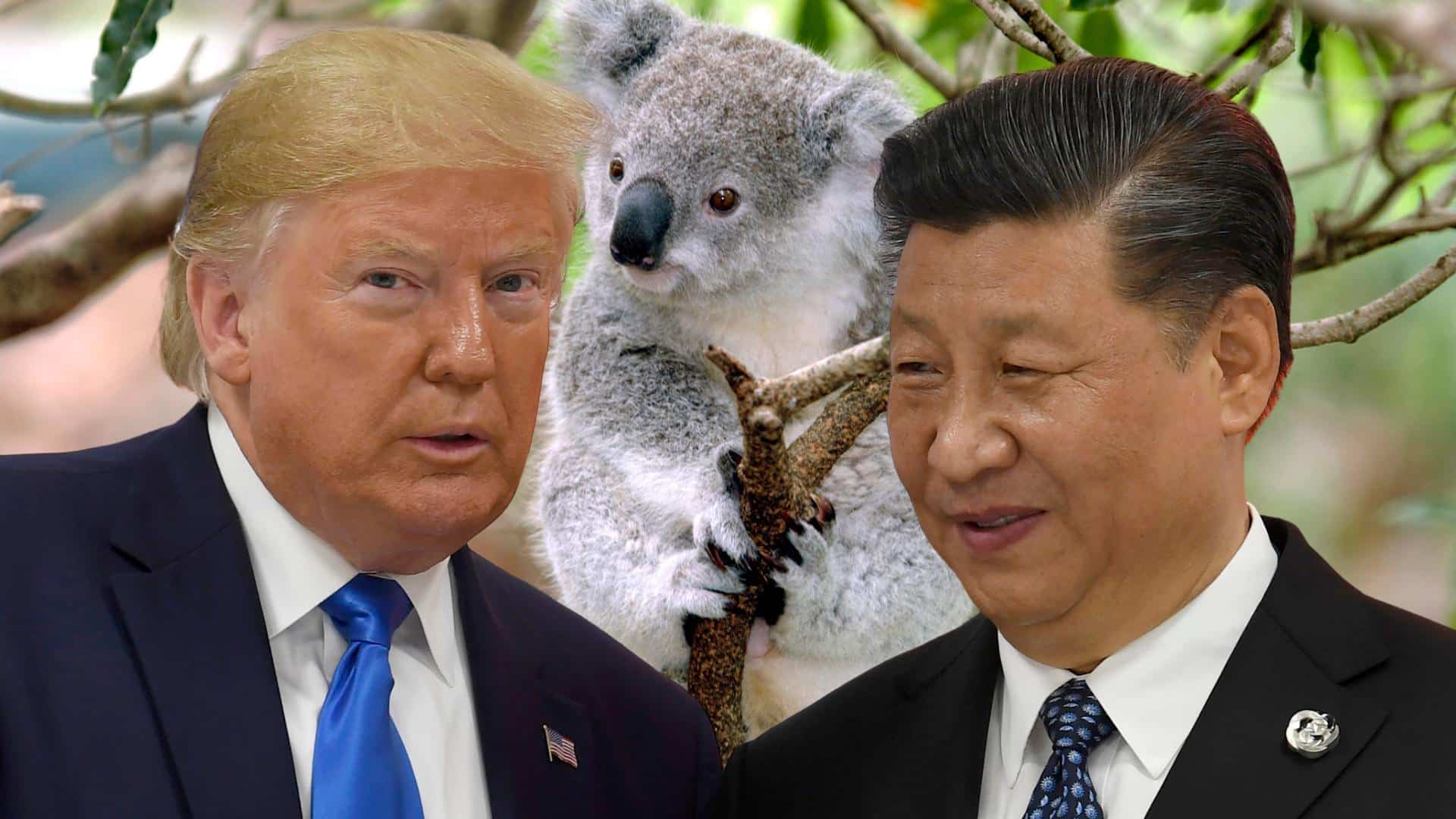Australia is its own continent but it has key strategic relationships with two big nations that don’t like each other. Political isolation is not an option.

A koala bear lurks behind U.S. President Donald Trump and China President Xi Jinping. (Illustration by News Decoder)
Editor’s note: On 3 May, Australians voted overwhelmingly to reelect Prime Minister Anthony Albanese and his Labor Party in a political turn-around largely credited to anti-Trump sentiment. His opponent, Peter Dutton, who lost his parliamentary seat as well in the election, had been known for anti-immigrant policies similar to those of U.S. President Donald Trump.
Many election watchers had noted that Australians are keenly aware that cozying up to Trump would cause friction in their relationship with China. To help explain this, we decided to republish an article, originally published in December 2023, when U.S. President Joe Biden was still in office, that explored the triangular relationship between China, Australia and the United States.
We launched Decoder Replay to help readers better understand current world events by seeing how our correspondents decoded similar events in the past.
After years of suffering a diplomatic cold shoulder from China, Australia is back on speaking terms with the government in Beijing.
At the same time, in the midst of the Israel-Gaza conflict, U.S. President Joe Biden recently took time out to host a full state visit by Australian Prime Minister Anthony Albanese.
So what is going on? Has Australia emerged as a new diplomatic powerhouse in the Asia-Pacific region?
Not quite. Since the election of a Labor Government in May 2022, Australia has radically changed from the previous government’s fairly gung-ho “all the way with the USA” approach to the region to one that is more nuanced and proactive.
The key to the new strategy is a reality that most democratic nations in the Asia-Pacific region currently face. The United States might be the region’s main strategic superpower, but China is still the key economic player.
Bipolar competition between superpowers
This reality was highlighted by the Lowy Institute, an independent, international policy think tank based in Sydney, in its annual Asia Power Index, now in its fifth year.
The 2023 index revealed that the Asia-Pacific region is increasingly characterised by bipolar competition between these two superpowers.
The index ranks 26 countries and territories in terms of their capacity to shape their external environment. It evaluates international power through 133 indicators across themes including military capability and defense networks, economic capability, diplomatic and cultural influence, as well as resilience and future resources.
The portrait that emerges from its latest survey is that while China’s overall power still lags the United States, it is not far behind, even though the current economic slowdown is holding it back in the short term.
After the two superpowers, trailing a long way back as the next most powerful countries in the Asia-Pacific are Japan, India, Russia and then Australia.
Economic versus military power
The index confirms that China draws its power from its central place in Asia’s economic system, while that of the United States comes from its military capability and unrivaled regional defense networks.
Australia’s relationship with the two mirrors the dilemma facing the whole region.
The United States is far and away Australia’s main strategic partner and has been since the Second World War.
In a deal signed in March 2023, Australia is set to acquire a conventionally-armed, nuclear-powered submarine capability with help from the United States through the AUKUS Treaty, which also involves the United Kingdom.
This was followed by plans to station more U.S. forces in Australia, especially in air bases in northern and western Australia. There are also moves to increase cooperation between both countries in space, speed up efforts for Australia to develop its own guided missile production capability and work with the United States to deepen security relationships with other countries in the region — most notably Japan.
This comes as Australia has been working hard to get trade restrictions eased with China after it imposed tariffs on a range of Australian products in 2020 during a standoff with the previous government.
Dining with Joe and Jinping
China is still Australia’s largest two-way trading partner in goods and services, accounting for almost one third of its trade with the world. Two-way trade with China grew 6.3% in 2020-21 to A$267 billion (about US$180 billion), mostly due to the coal and iron ore sectors.
So as it stands, Australia’s security relies on the United States but its economic prosperity is heavily influenced by China.
It’s no surprise then that Prime Minister Albanese had to walk a fine line in 2023 — going from a state dinner at the White House with U.S. President Biden on 26 October to meeting with Chinese president Xi Jinping 11 days later.
Colin Heseltine, a former Deputy Head of Mission at the Australian Embassy in Beijing and now senior advisor for independent think tank Asialink, said Australia is in a conundrum over China.
“Australia’s major trading partner is also perceived as our No.1 security threat,” he said.
Normalizing relations before an abnormal U.S. election
Heseltine believes there is a mood of cautious optimism about the growing relationship between Australia and China since the election of the Albanese government, but expects the future will not be completely free of headwinds.
In the end, Australia, like many other nations in the region, is pragmatically making the situation work. It has seen relations with Beijing normalize, or as some prefer to describe it, stabilize.
As for the United States, relations between Canberra and Washington remain vibrant and strong.
The next big issue for Australia in managing this twin policy of improving ties with the Asia-Pacific’s two diverse superpowers could well be the 2024 U.S. presidential election — who wins it and if China features in it.
And those things are outside its control.
Three questions to consider:
1. What is the emerging dilemma facing most democratic nations in the Asia-Pacific region?
2. Is China likely to overtake the United States as the Asia-Pacific’s major superpower anytime soon?
3. What is the biggest threat to the current status quo facing nations in the region?

Richard Hubbard is a finance and economics journalist with more than 35 years reporting from Australia, the UK, Asia and the United States. He is currently a freelance journalist based in Sydney. Hubbard covered the Asian financial crisis of the late 1990s from Hong Kong and Singapore, and later the run-up to the 2008 financial crisis and its aftermath from London.
